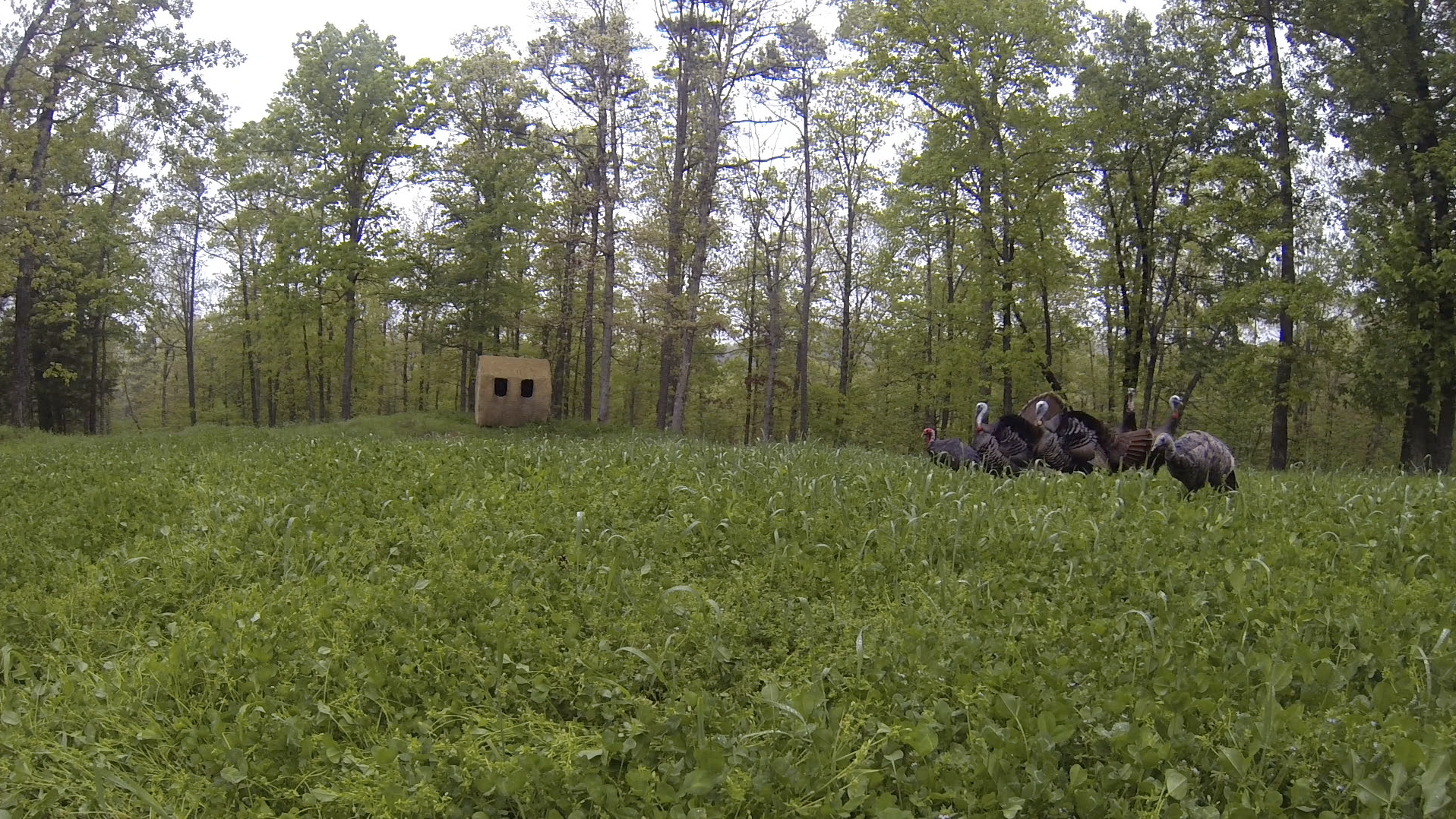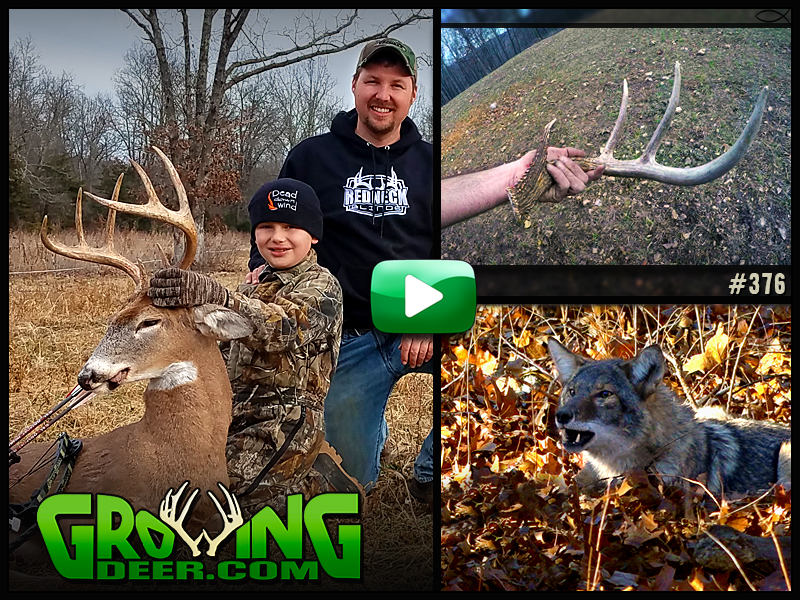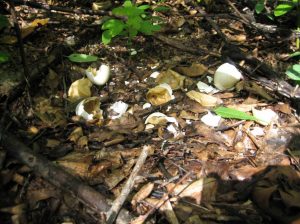Category: Hunting Blog
Scouting and Early Season Success
March is almost over, and for most of us, it’s time to start scouting for those early season gobblers. We’re all getting excited for turkey season here at The Proving Grounds. One of the ways we’re prepping for it involves the same tools we use to scout deer in the fall.
We’ve moved many of our Reconyx game cameras to spots where they can capture time-lapse pictures of an entire food plot. By doing this, we should be able to see where turkeys are spending their mornings after leaving the roost. Hens tend to seek out openings during the morning while it’s still cool, and where the hens are, toms will follow. Even though their roosts will change over the next month, most of the turkeys will revisit the areas where they have been eating and mating throughout the season.
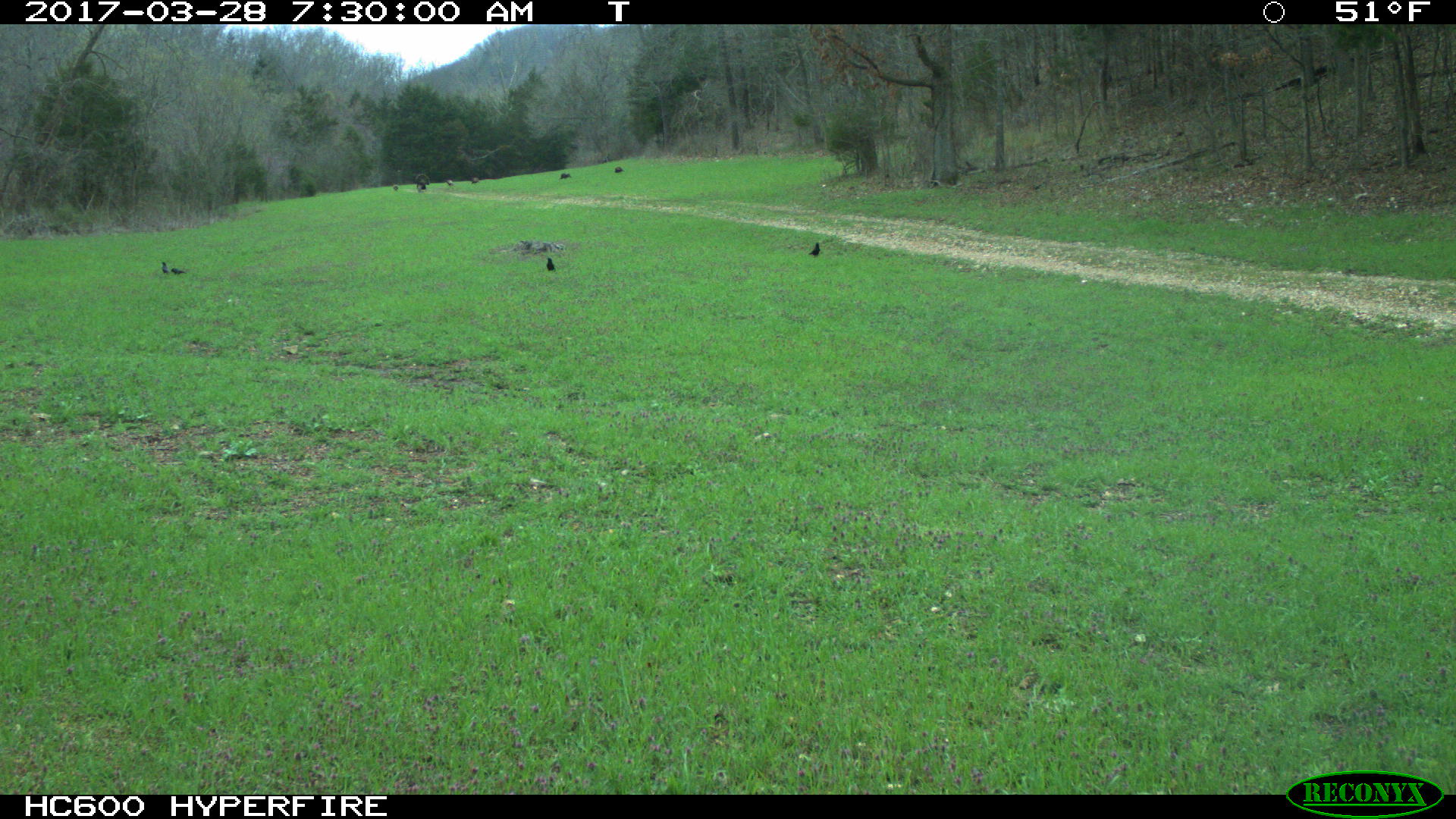
Setting the camera on time lapse mode and placing it high enough to capture the entire field is a great way to monitor large fields for turkey movements!
Scouting turkeys is an important pre-season strategy, and it can lead to exciting turkey hunts. Find that early morning spot where turkeys are flying down to, and enjoy creation as you hunt the early season.
Enjoy Creation,
Jessica
4 Ways You Can Improve Your Turkey Hunting Footage
Turkey season is upon us! One thing more turkey hunters are doing is filming their own turkey hunts. It seems there are two types of filmed turkey hunts. Amazing films that capture everything turkey hunting is about and films that show a gobble or two, some blurry footage of a turkey, and a loud boom. Dr. Grant Woods of GrowingDeer films countless turkey hunts every year. Woods loves turkey hunting and he enjoys capturing the hunt on film. Below are a few of his tips to ensure you end up with a film all your friends will want to watch.
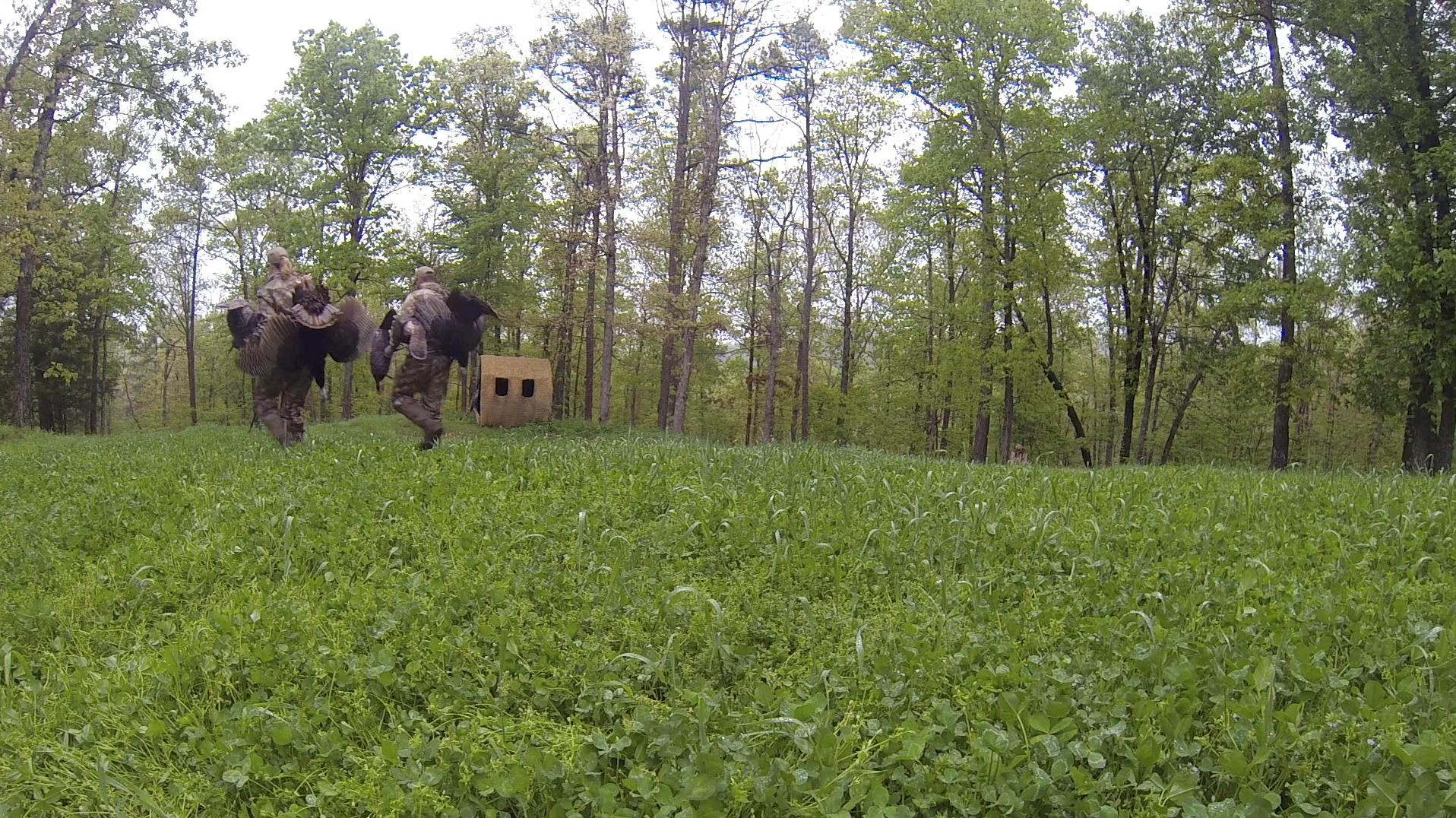
KEEPING CAMERA GEAR CONCEALED
Most turkey hunters run and gun at some point during their season. Unlike deer hunting where most hunters are stationary and can take their time setting up their camera, turkey hunting requires hunters to be on the move which often makes filming more difficult. “Often turkey hunters are forced to set up in a hurry so little details like making sure the camera is completely concealed gets missed. A turkey will spook the moment they see a big black camera or a bright shiny camera lens. We try to hide the cameraman near a big tree or bush. Then we cover the camera with a cloth so the birds can’t see the camera or the lens. Carrying all this around when we are hunting can be difficult, but it is worth the effort because we spook fewer birds and get better footage,” Woods explained.
A DECOY IS A MUST HAVE TOOL
Turkey hunters often debate whether they should use decoys when turkey hunting because decoys can sometimes spook birds. According to Woods, decoys are often required when filming a hunt. “A decoy takes the birds’ attention off where the calling is coming from and then they focus on the decoy. We put the decoy about twenty yards from our set up and even closer if we are bow hunting. With a decoy close, we can get good footage of a tom when he comes into the decoy,” Woods added.
HUNTING FROM A BLIND
When Woods and his team notice a tom and his ladies are regularly hanging out in a food plot or field, they often set up a Redneck Blind near the field edge. “The wonderful thing about hunting out of a blind is it conceals your movement and the turkeys don’t seem to get spooked by a blind. They don’t pay attention to them. In addition, all the filming from a blind is much easier than running and gunning. Every turkey hunter should have a blind, especially if a person is going to bow hunt. A blind conceals the cameraman and the hunter when they draw their bow,” Woods noted.
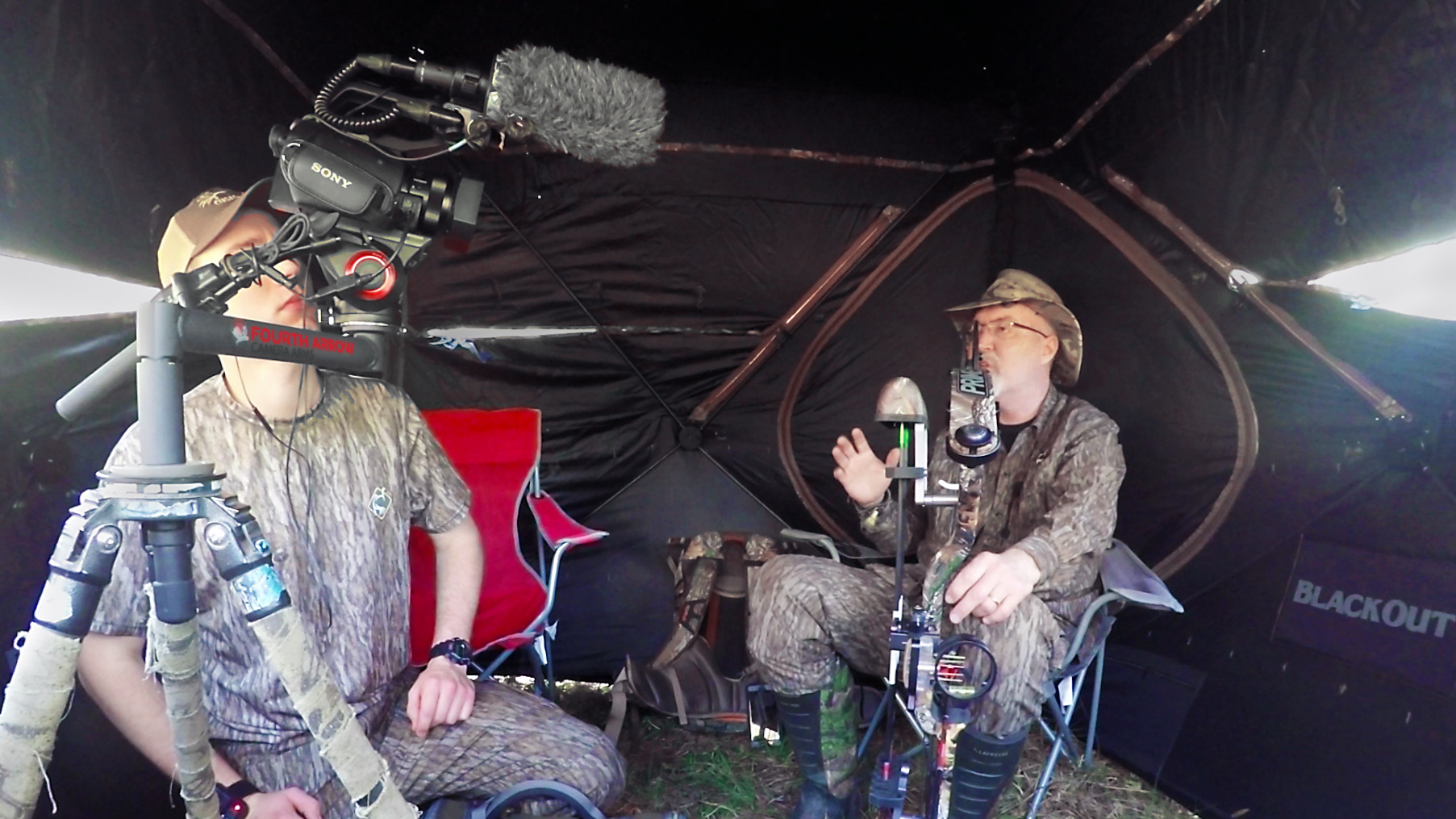
THE REX ARM
One item that has changed the way Woods and his team films turkey hunts is the Rex Arm from Fourth Arrow Camera Arms. This camera arm can be used with almost any tripod and it allows the hunter to move the arm with the camera attached without moving the tripod when filming. “Turkeys often come strutting in and moving around. In order to keep them in the viewfinder, we have to move the tripod. The Rex arm is an efficient system, allowing the hunter to utilize 360 degree movement within a 10-inch radius of the tripod. Now we can easily move the camera and keep up with the gobbler without having to jerk the tripod around. It minimizes movement and increases the quality of our footage,” Woods added.
Filming a turkey hunt is fun and exciting. Hopefully the tips above will help you produce a better film this spring that you will be able to enjoy for years to come.
Advanced Trail Camera Tactics
Trail cameras have become a pivotal tool for whitetail hunters. They are beneficial in so many ways and allow us to scout every hour of every day for the entire year. Sometimes bucks show up on trail camera during certain time periods only to disappear days later. I thought this was the case for a particular buck I got a few pictures of during January of 2014.
This buck showed up on the fringes of the property I hunt and he appeared to be a solid three-year-old 8 point with potential. I soon forgot about the deer as the seasons changed, then fall rolled around and he was back. He carried a wide, thin rack and was a regular on the property but I had my sights set on another older buck. All my efforts that deer season and the next were focused on harvesting other deer so he flew under my radar. During the winter of 2015, two years after my first pictures of the wide 8 point, I browsed through all my trail camera images of mature bucks and realized this buck had blossomed into a very nice deer. I placed him at the top of my 2016 hit list.
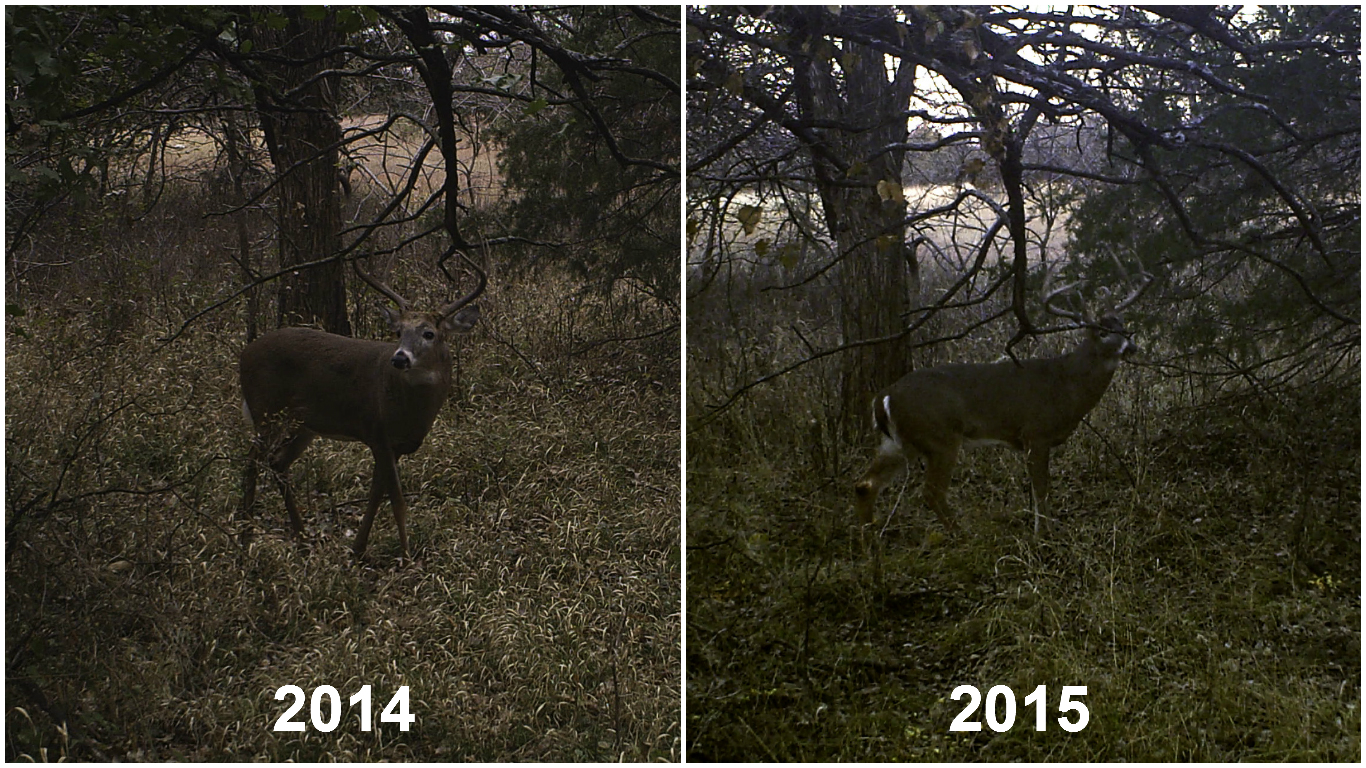
As the fall of 2016 progressed, I did not have a single image of this buck. He usually showed up around the first of October; I had some worries but I remained hopeful he was still alive. My worries soon vanished during my first hunt of the year. On the morning of October 30th we crossed paths and I was able to write the final chapter on the story of the wide 8 point. By using trail camera data from previous seasons, I was able to determine when and where this buck made appearances which helped me pick strategical blind and stand locations.
The use of cameras can be a fun way of determining what animals are on your property, however, they can also be utilized in more advanced ways. I have found that the biggest advantage is the ability to predict movement of mature bucks based on movements from previous seasons (watch the hunt for Handy here to see this tactic in action). When next deer season comes around, open up last year’s images and study them in depth. Look at dates, times, temperature, wind direction, barometric pressure, and a host of other factors that may give you an upper hand on tagging your next mature buck!
Enjoy Creation,
Tyler
Providing Minerals for Deer Herd Health
The first signs of spring are popping up all around us here in southwest Missouri. Wildflowers are beginning to bloom, spring peepers are out at night, and many Ozark critters are already out of hibernation. An early spring is upon us! This is good for whitetail growth because it brings an end to the winter stress period. With spring green-up, deer will begin to recover the weight they lost during the winter and start to stock up on minerals that they will later use for antler growth or fawning.
It’s important to have forage and minerals available on your property year round. This gets most deer through the stress period and keeps them around for spring green up. In addition to our food plots, we use Trophy Rock as a supplement mineral year-round. The deer will initially store these minerals in their skeleton, and when the time is right, their bodies will convert the minerals into a form that they will use to grow antlers or for fawning.
Providing a steady supply of minerals throughout the year, along with quality forage and age, helps deer reach their genetic potential. With spring just around the corner, now is a great time to start providing Trophy Rock to the deer where you hunt. Not only will you be supporting the health of the deer population after their most stressful time of the year, you’ll also have a great spot to stick a game camera and check out the post-season deer population on your property.
Enjoy creation,
Jessica
Soil Samples and Healthy Roots
Soil is the foundation that a food plot stands on, so it’s important to know how solid that foundation really is. A soil sample is a quick and easy tool that can help you maximize your food plot’s yield and save you time and money when it comes to fertilizing. Taking the sample is simple and only takes a few minutes to collect. All you need is a shovel or a soil probe, a bucket and some plastic bags.
Your local extension office can test the soil for you, or you can choose to use a private lab. We use Waters Agricultural Laboratories because of their quick service and we want our plots tested for maximum yield instead of the most economic yield, which is what most extension offices provide.
By taking a soil sample for every food plot, you can determine exactly how much fertilizer or lime is necessary for each plot to produce quality forage. This saves money and healthy plants are much more attractive (palatable) to deer than malnourished forage.
Jesus tells us in Matthew 13 that seeds cast on poor soil will quickly wither and die. This is true both spiritually and literally. If your plants, or your faith, are not rooted in quality soil, there is no way either can grow to their full potential. Make sure you’re taking care of both.
Enjoy Creation,
Jessica
Life & Deer Hunting
Life and deer hunting have a lot in common. One similarity is that to have repeated success one must pay attention to the little things. My friend and fellow deer hunter, Andy Andrews, has a new book about the little things.
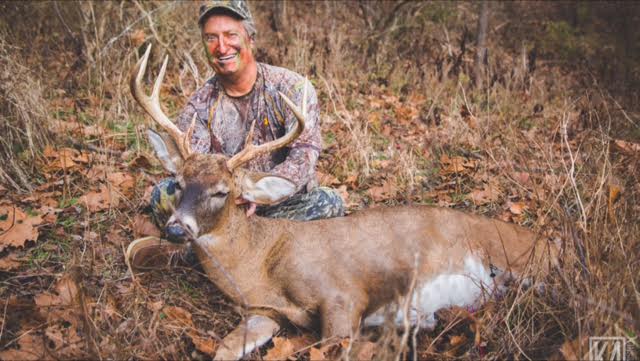
 It’s not another book about deer hunting tactics or based on a one time wonder of tagging a monster buck. It is a brilliant collection of principles that can be applied to deer hunting and all aspects of life.
It’s not another book about deer hunting tactics or based on a one time wonder of tagging a monster buck. It is a brilliant collection of principles that can be applied to deer hunting and all aspects of life.
Want to have a better year during 2017 than you had during 2016? Take a positive step and read Andy’s new book, The Little Things. Order it here.
Enjoy creation,
Grant
Fire, Habitat and Hunting
Deer season is over and turkey season is just around the corner. That means the work is just beginning.
We have several large prescribed fires planned for the week. Right now, I am sitting in the office catching up on several tasks while the interns mix fire fuel and pack the leaf blowers in the Yamaha. Today we plan to burn several large bedding areas. These areas are designated sanctuaries for our deer herd.
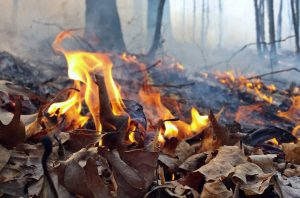
Prescribed fire is a great tool for habitat management.
Last fall Flatwood Natives Habitat Solutions sprayed all the hardwood saplings in these areas. The saplings have had several months to die and dry before the prescribed fire. Our goal today is to burn the native grasses and forbs, encouraging new growth this spring. The saplings may remain standing but fire will make them even more brittle and assist in a timely decomposition.
As a wildlife manager and hunter I am very excited to burn these areas. I can’t stop thinking about turkeys. Burned areas make for great bugging areas for turkeys. The terrain is open and turkeys can watch for predators and find great food sources. This can make for some great spring turkey hunting.
Turkeys are on my immediate radar but I cannot forget about the deer. Within a few months these burn areas will serve as great fawning habitat. As new tender grasses and forbs pop up over the next few weeks, these burn areas will also be a great food source for deer. Of course, the hunter in me will be looking for sheds and trails trying to figure out which deer are in the area and how they are using the terrain. These prescribed fires make for some great late season scouting!
We will be very busy today and during the next few months with prescribed fires. Each fire brings a great reward – improved habitat and better hunting. I hope you get the chance to work on your Proving Grounds soon and can enjoy the fruits of your labor come hunting season.
Enjoy Creation,
Daniel
The Late Winter Stress Period
We have been blessed with a mild winter at The Proving Grounds. Even so, the local deer herd seems hungry. Late winter is a stressful time for whitetails across most of their range. Lack of food, cold temperatures, and months of hunting pressure create a potent mixture of hardship. During this time, deer are trying to regain the weight lost during the rut. They must also start preparing for the spring fawning season and period of antler growth.
During this time of year, there is often a shortage of the forages whitetails need to sustain a healthy weight throughout the winter. This period of deficiency is intensified in times of drought. In many areas, most native forages have been browsed to exhaustion which brings up the importance of food plots during late winter. As you may have noticed in some of our recent images, the forage in the food plots at The Proving Grounds have been heavily browsed. We tagged more does during 2016 than during previous years due to the drought and increasing deer population. This spring we plan to establish a few more acres of food plots. Our objective is to reduce stress and increase the health of the local whitetail herd during the annual winter stress period.
In addition to establishing and maintaining food plots, we are using prescribed fire to improve the quality and quantity of native forage. Stay tuned, watch our progress and see how the deer herd responds!
Enjoy creation,
Tyler
Late Season Buck Fever – Episode #376
New Video
Watch Seth and Trace Harker successfully hunt late season food sources! Both Harkers get a bad case of buck fever but each finds the remedy. Plus, there’s a trap line double at The Proving Grounds!
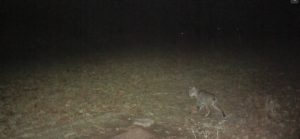 Short Clip:
Short Clip:
Watch as the Reconyx picks up a spike in bobcat activity during their breeding season!
New Weekly Blog:
Find out why we trap predators year after year and the benefits we see!
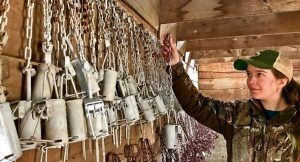
Tip of the Week:
Cleaning and storing traps in dry conditions after season helps extend the life of your Duke traps.
Trapping Predators Boosts Nest Success
Tuesday marked the end of a successful trapping season at The Proving Grounds. We’re excited to have removed 41 predators from the property by trapping daily and using a variety of baits to bring them into our Duke traps. That means most likely more turkey poults, quail chicks, and fawns will survive!
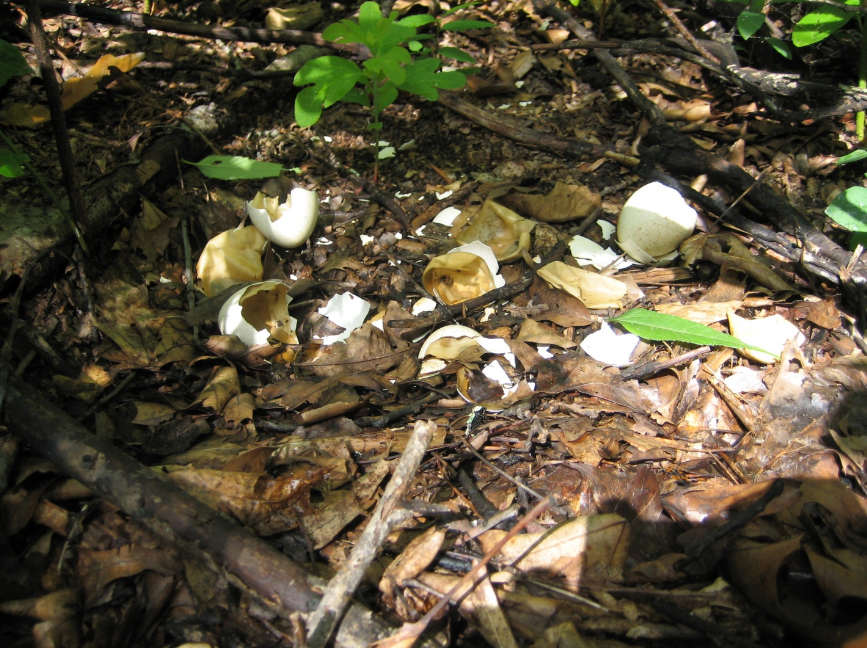
Nest predators can cause serious damage to a turkey population.
The GrowingDeer Team has been trapping predators consistently for seven years in an effort to balance the predator and prey population. We’re serious about trapping because studies show that racoons, opossums, and skunks are intense nest predators. Turkeys are especially susceptible to predation because they nest on the ground for approximately 28 days and then roost on the ground for approximately two weeks until the poults can fly.
It almost always rains at least once during the nesting season and wet hens have an odor even humans can easily smell. This makes it very easy for predators to find turkey nests and consume all the eggs and even kill the hen at times. Researchers used to call this the wet hen theory but it’s not just theory.
Last year The Proving Grounds had a high turkey poult survival rate compared to the statewide average. This was in part because of the serious effort the team has put into trapping. As land managers and hunters, we want a healthy turkey population! By trapping predators, we are one step closer to a successful turkey season.
Enjoy Creation,
Jessica



